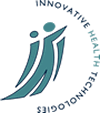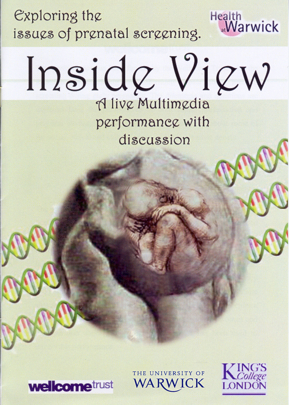IHT Programme
FINAL INTERNATIONAL CONFERENCE
27 October 2005, Church House, Westminster, London
Report on the IHT Final Conference
(Adobe Acrobat 6.0 required)
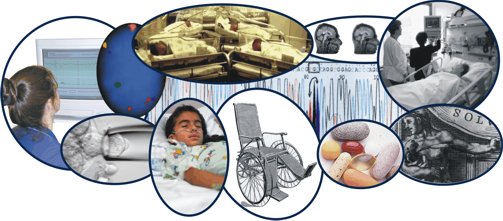
|
Conferences can be rather predictable, flat affairs, or lively, inclusive and genuinely shared occasions where the combination of interesting papers, a good mix of delegates, and an excellent venue produce an event that was worth going to. (A good wine reception at the end also helps!)
|
|
|
|
|
|
Such it was with the closing event of the IHT Programme which brought together over 130 people to explore the implications of work that had been undertaken in two phases over the five years. The most striking feature of the conference was the way in which the formal presentations covered projects that ranged across the Programme: how many other times have you seen six projects captured in a twenty-five minute slot? Each presenter, from a specific project, had a clear sense of Programme-wide outcomes. Of course, this capturing tends to codify and schematise results but these are all available in full on the Programme web site, and this was at no real cost to the ensuing debate.
|
|
 |
Clare Williams gave an overview (here) of a number of projects that focus on the implications of reproductive and transformative technologies, notably genetic screening. Framing her commentary around the increasing use (and pace) at which screening occurs, she explored the implications this has for risk communication and informed choice. Screening not only provides information about genetic risk, but generates a range of attendant risks that the clinician/patient had not anticipated: there is a need for more information, but what information is it to be? The routinisation of screening tends to create a 'risk escalator' which is difficult to opt-out of. She argued that the IHT results showed that there is a need for new ways of communicating risk, that genetic counselling needs to be more properly rooted in the context the patient brings to the encounter, and that the risk/context nexus differs across conditions and patterns of health care. The Department of Health is currently exploring some of these issues and detailed results from the Programme projects will be made available to Richmond House.
|
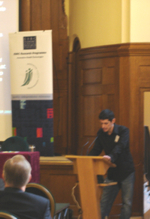 |
Simon Cohn then provided (here) a conceptually rich analysis of the sense in which we can conceive of information technology as in some way empowering patients and users, in a 'techno-democracy'. ICTs enable a multiplication of experts as well as a reconfiguring of patients as datum: medicine becomes information as much as information becomes medicine, the medical record creating the medical subject while shaping the very meaning of doctor/lay relations. This subverts too the tendency towards a linear narrative of the patient, of patient pathways and trajectories, not least by asking at what point are people to be regarded as 'patients' and when and indeed how might they adopt the 'sick role'? As Simon argued, this leads towards a patient who as subject is 'open-ended', but in contrast there is an experiential and clinical need for a grounding of the patient, where a sense of risk and responsibility can be anchored. Trust is a core issue here, and the difficulty of building a sense of meaning through or even despite a redundancy of information; as he emphasised in his closing remarks, patient ideas abut health and illness derive from social relations that make information meaningful.
|
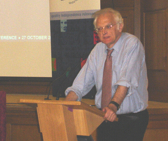 |
John Pickstone closed the morning session with a paper (here) that he and his Manchester colleague Stan Metcalfe had prepared, reviewing those projects from the Programme that had had a specific focus on the dynamics of innovation. In a discussion of projects ranging from wheelchair design to prosthetics, John argued that if innovation is to be successful it had to start with the people who use technologies. And that research should focus as much on the experience and framing of health and illness in settings such as nursing and residential care homes, as it does on the technical shifts and developments that mark out IHTs. Mundane technologies in mundane settings in an age of chronic illness are as central to quality of life as are the more high-tech innovations which attract so much attention. Through a detailed discussion of his and Stan's projects on the prosthetic hip joint and the intraocular lens, he showed how innovation is rarely a case of applying some model system developed in a science or engineering lab, but is much more about the gradual stabilisation of a system around a design that inscribes a wide range of interests and economic and political agendas. Technical success is then, as is technical failure, a social as much as it is a material achievement, and may well vary according to the circumstances of differing constituencies of interest.
|
 |
The morning session ended with an address by the Chief Executive of the ESRC, Professor Ian Diamond, who stressed the importance of research supported by the Council that crosses the social and bioscience domains and that has high theoretical value and strong policy relevance. The Programme was one that he saw making an important contribution to such work and to the Council's research portfolio in the field of health.
|
|
|
The afternoon opened with high drama: a theatrical representation of one of the IHT projects (led by Gillian Lewando Hundt) on prenatal genetic screening. The theatre company, directed by Claudette Bryanston and made up of Tinch Minter, Kathy Joyce and Saul Cross, performed 'Inside View' (image from front cover), a multimedia performance of the dilemmas and uncertainties faced by a woman during her early pregnancy, whose foetus is screened for possible genetic disorders including Downs. The play used backdrop still and moving images to set different scenes against which the actor, Kathy Joyce, gradually moved from the initial delight of pregnancy to the uncertainties and risks generated by the screening process itself. The loss of control, the sense of 'other', the questions thrown up by clinical advice, and the speed at which this all happened, captured in drama the social science results that Gillian and her team have been publishing in more conventional academic forms. The power of this type of dissemination was clear to all in bringing to the fore ideas and issues that can never be properly captured by the written text alone. The whole event was given more impact by being held in the circular assembly room (where once the Church of England's synod deliberated), an amphitheatre that no doubt in its past had heard theological debate over but rarely social science critique about reproductive technology.
|
 |
Following this, the meeting turned to the final two papers of the day, presented in more conventional conference mode. The first by John Abraham (here) reported on a number of projects that had addressed the question of the regulation of new technologies, such as those not only by John himself on the pharmaceutical industry, but also projects by Faulkner et al., Martin et al., Salter et al., and Michael et al.. One of the key findings is that we should not assume that regulation has hampered innovation - say in drug development - since data from across the projects shows that more and different regulation could in fact stimulate innovation. Moreover, John pointed out that regulation is confronted by increasingly hybrid objects, such as tissue engineering products and devices, that do not fit existing regulatory categories. Innovation thereby transforms how regulators define the object of regulation itself and this two-way process is one that requires more sophisticated regulatory manoeuvres as well as new forms of accountability and governance.
|
 |
The final paper of the day (here) was presented by Carl May who offered a powerful critique of the meaning and process of technology evaluation that characterises the 'evidence-based state'. He argued that what matters today is 'what works' and what works is itself highly political. Two core narratives of evaluation can be found in contemporary medicine: one that reduces patients' understanding and experience of health to datasets and statistical norms that mean little and yet are so powerful; and patient satisfaction surveys that appear when clinical trials need to be buttressed by more 'qualitative' forms of evidence. Evaluation tends towards a progressively minimising set of reductive, typically quantitative measures. Carl stressed the need for new forms of evaluation that can track performance and cost/benefit in new ways and that most importantly recognise the context within which technologies actually become workable, become normalised. The IHT Programme's data, through research on telemedicine, and through David Armstrong's critique of Quality of Life measures, suggest both the limitations of conventional evaluation and entry points for a more socially grounded and thereby effective set of techniques for considering the actual effect and efficacy of IHTs.
|
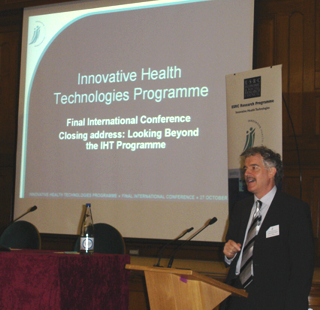 |
The final session was the closing address (here) by the Programme Director, Andrew Webster, who identified a number of future research priorities that need to be addressed in light of the Programme results. One key area is the way in which the move towards patient choice and home-based technologies poses new questions relating to risk, patient safety and clinical governance. He drew attention to the new DoH Strategic Implementation Group's proposals for developing incentives and schemes to promote the introduction of IHTs into the NHS. He would be relaying the result of the Programme to the Group, continuing the contribution the Programme has made to debate in Whitehall.
|
|
A drinks reception closed the day
and was a welcome health technology that needed no formal evaluation
to determine whether it was cost-effective!
Professor Andrew Webster
A copy of the Jon Turney article 'People, Technology and Health: Highlights of the Innovative Health Technologies Programme' can be found here.
|
|
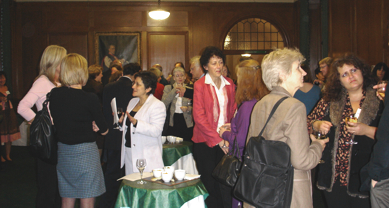 |
|
 |
|
